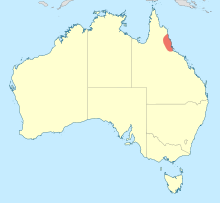Agriocnemis dobsoni
Agriocnemis dobsoni is a species of damselfly in the family Coenagrionidae,[3] commonly known as a tropical wisp.[4] It is a small damselfly; mature males have a white pruinescence over their body, and a dark end to their tail.[4] It is endemic to north-eastern Australia,[5] where it inhabits pools and swamps.[6]
| Tropical wisp | |
|---|---|
| Scientific classification | |
| Kingdom: | Animalia |
| Phylum: | Arthropoda |
| Class: | Insecta |
| Order: | Odonata |
| Suborder: | Zygoptera |
| Family: | Coenagrionidae |
| Genus: | Agriocnemis |
| Species: | A. dobsoni |
| Binomial name | |
| Agriocnemis dobsoni | |
 | |
Gallery
.jpg) Female wings
Female wings.jpg) Male wings
Male wings
gollark: Waiting for materials for more expensive weapons, not that they'll probably do much.
gollark: That's what I'm doing. It's great.
gollark: How did you get that without building anything then?
gollark: Ooh. What's the maximum level?
gollark: - Weapons have a cooldown of 1 hour. Therefore, it is best to go around firing them every hour or so.- Firing weapons at people's stuff is required to level up and get new decorations.- If you wait a long time, people will probably have better equipment than you, so you will get even less XP.
See also
References
| Wikimedia Commons has media related to Agriocnemis dobsoni. |
- Dow, R.A. (2017). "Agriocnemis dobsoni". IUCN Red List of Threatened Species. 2017: e.T163543A87522933. doi:10.2305/IUCN.UK.2017-1.RLTS.T163543A87522933.en.
- Fraser, F.C. (1954). "Two new species of Odonata from Australia". Annals and Magazine of Natural History. 7 (74): 145–149 [147]. doi:10.1080/00222935408651709.
- "Species Agriocnemis dobsoni Fraser, 1954". Australian Faunal Directory. Australian Biological Resources Study. 2012. Retrieved 6 April 2017.
- Theischinger, Günther; Hawking, John (2006). The Complete Field Guide to Dragonflies of Australia. Collingwood, Victoria, Australia: CSIRO Publishing. p. 100. ISBN 978-0-64309-073-6.
- Watson, J.A.L.; Theischinger, G.; Abbey, H.M. (1991). The Australian Dragonflies: A Guide to the Identification, Distributions and Habitats of Australian Odonata. Melbourne: CSIRO. ISBN 0643051368.
- Theischinger, Gunther; Endersby, Ian (2009). Identification Guide to the Australian Odonata (PDF). Department of Environment, Climate Change and Water NSW. p. 189. ISBN 978-1-74232-475-3.
This article is issued from Wikipedia. The text is licensed under Creative Commons - Attribution - Sharealike. Additional terms may apply for the media files.
